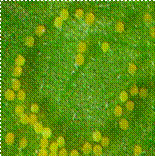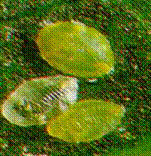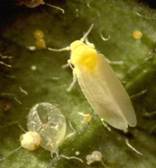Crop Protection :: Cash Crop :: Pest of Cotton
| Whitefly: Bemisia tabaci |
 |
Symptom of damage
- Chlorotic spots on the leaves which latter coalesce forming irregular yellowing of leaf tissue which extends from veins to the outer edges of the leaves
- Severe infestation results in premature defoliation
- Development of sooty mould
- Shedding of buds and bolls and poor boll opening
- It also transmits the leaf curl virus diseases of cotton
|
Identification of the pest
|
|
Management
- ETL: 5 - 10 /leaf
- • Avoid the alternate, cultivated host crops of the white fly in the vicinity of cotton crop
• Growing cotton only once a year either in winter or summer season in any cotton tract
• Adopting crop rotation with non-preferred hosts such as sorghum, ragi, maize etc., for the white fly to check the build up of the pest
• Removal and destruction of alternate weed hosts like Abutilon indicum (Thuthi), Chrozophorerottlari(Purapirakkai), Solanumnigrum(Manathakali/Milaguthakali, Chukkittikeerai)
and Hibiscus ficulensusfrom the fields and neighbouring areas and maintaining field sanitation
• Timely sowing with recommended spacing, preferably wider spacing and judicious application of recommended dose of fertilizers, particularly nitrogenous and irrigation management is essential to arrest the excessive
vegetative growth and pest build up. Late sowing may be avoided and the crop growth should not be extended
beyond its normal duration
• Field sanitation may be given proper attention. Cultivation of most preferred alternate host crops like brinjal, bhendi, tomato, tobacco and sunflower may be
avoided. In case their cultivation is unavoidable, plant protection measures should be extended to these crops
also
• Monitoring the activities of the adult white flies by setting up yellow pan traps and sticky traps at 1 feet height above the plant canopy and also in situ counts
• Collection and removal of whitefly infested leaves from the plants and those which were shed due to the attack of the pest and destroying them
- Chemical control:
• Acetamiprid
20% SP 100 g/ha
• Azadirachtin 0.15% 500-1000 ml/ha
• Buprofezin 25% SC 1000 ml/ha
• Chlorpyriphos 20% EC 1250 ml/ha
• Clothianidin 50% WDG 40-
50 g/ha
• Diafenthiuron 50% WP 600 g/ha
• Fipronil 5% SC 250-340 ml/ha
• Imidacloprid 17.8% SL100 -125 ml/ha
• Profenofos 50% EC 1000 ml/ha
• Thiacloprid 21.7% SC 500-600 ml/ha
• Thiamethoxam 25% WG 100 g/ha
• Triazophos 40% EC 1500-2000 ml/ha
- Spray any one of the following plant products alone or in combination with the recommended dose of insecticide (at 2 ml/l of water)
- • Neem seed kernel extract 5% (50 kg) and neem oil at 5 ml/l of water
• Fish oil rosin soap 25 kg at 1 kg in 40 lit of water
• Notchi leaves 5% extract Catharanthusroseaextract 5%
- Spray any one of the following in early stage (500 l of spray fluid/ha)
• Phosphamidon 40 SL 600 ml/ha
- Spray any one of the following in mid and late stages (1000 l spray liquid/ha)
• Triazophos 40 EC 2.0 l/ha
• In the early stages with high volume sprayer, use a gooseneck nozzle to cover the under surface of the foliage to get good control of the pest. If high volume sprayers are not available, 375 litres of spray fluid may be used per hectare for application in the low volumemotorised knapsack mist blower
• The use of synthetic pyrethroids should be discouraged in cotton to avoid the problem of whitefly
• Cypermethrin, fenvalerte and deltamethrin cause resurgence of whiteflies
• So avoid repeated spraying of pyrethroids
• The plant protection measures should be adopted on a community basis in a specified cotton areas
- Biological control: Verticilliumlecanii1.15% WP 2500 g/ha
|
|




